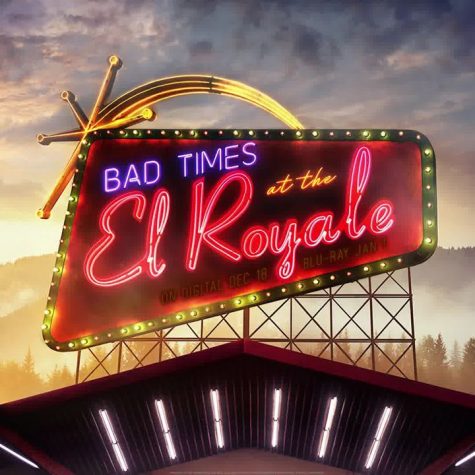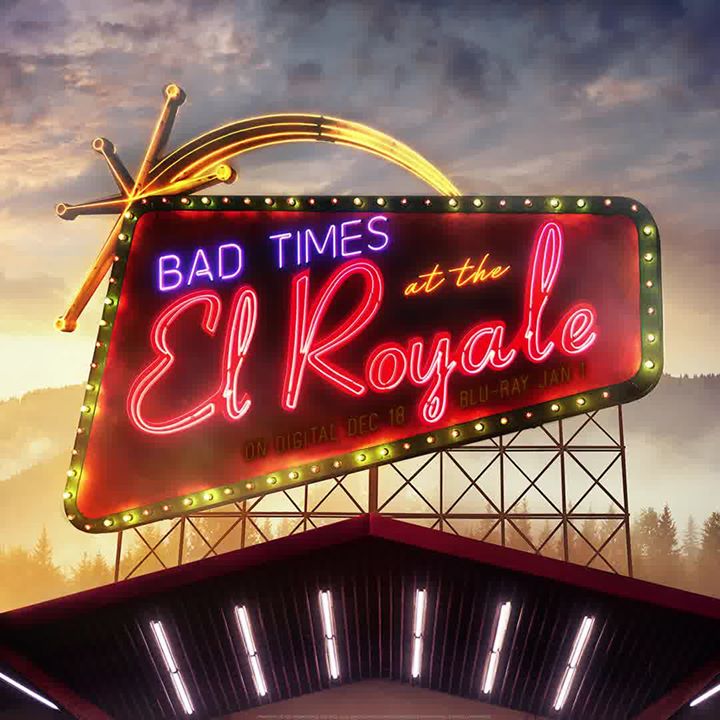Humanities Catches a Flick in the City
Bad Times at the El Royale

A priest, a singer, and a vacuum salesman enter an abandoned hotel. No, this is not the setup for an overused joke. It is the start of the hard-boiled noir film Bad Times at the El Royale, directed by Drew Goddard. The movie’s primary focus seems to revolve around the unexpected; nothing is exactly how it appears. This uncertainty culminates into an eventual all against all mentality. With a stellar cast consisting of the likes of Jeff Bridges, Jon Hamm, and Chris Hemsworth, the movie definitely had an expectation to meet. To this end, Goddard masterfully portrays the events with his excellent cinematography, exemplified by his manipulation of setting to produce an intended mood of fear, suspense, and anticipation combined with effective angles and strong foreshadowing. However, the movie’s inconsistent plot line, while adding a level of uniquity, introduces the viewer to a confusing telling of an otherwise dark and scandalous crime thriller.
The movie opens with a single frame of a hotel room, with the door at the center. A man (Nick Offerman) walks in, puts his bag on the bed, and pulls out a gun, examining the room. Already at the start of this film a sense of alarm and danger pervades; this movie does well to tease the viewer with anticipation. The man then begins to tear the room apart, removing the floorboards to hide his bag; clearly something valuable, or sinister, is being stashed. This is reinforced when, after a couple scenes showing the man’s fear and agony build up, the man is killed in this very hotel room by an unknown character. This sequence of events is all portrayed through one continuous camera angle. This angle, while emphasizing the man’s confinement, is also a foreshadowing of a later element that introduces a significant conflict. In the opening scene alone, the viewer is exposed to a sense that something deplorable is to come; this was not just a normal man relaxing in his hotel room.
Flashing forward to circa 1969, the movie continues on this track of uncertainty with the death of this unknown man looming over the story. Goddard makes masking true identity and form a significant theme throughout the movie. The characters themselves seem odd and out of place. A priest (Jeff Bridges), a singer (Cynthia Erivo), a vacuum salesman (Jon Hamm), a hippie (Dakota Johnson), and a kidnapping victim (Cailee Spaeny) have somehow all gathered at a run down hotel on the border of California and Nevada, and they all are somehow not exactly who they claim to be. For example, the vacuum salesman is the first character to have his true identity revealed. The salesman is an undercover FBI agent on duty at the hotel; through a scene depicting him searching his room for bugs, the viewer is once again introduced to crime and anticipates some action as a result. However, in line with the movie’s nature of uncertainty, it is never explicitly explained why the FBI were involved at the El Royale; the viewer is left to make his or her own answers. Perhaps the only character that the movie does not portray under a facade is Billy Lee (Chris Hemsworth), who makes an extravagant entrance and a exit towards the end of the film and is very certain in his role as a cult leader.
Furthermore, Goddard makes a significant use of his setting to play out the events in the story. The hotel, positioned on the border of California and Nevada, somewhat represents the line between good and evil, moral and immoral. This is embodied by a literal line that marks the border between the two states. On many occasions, the movie displays characters along this line, both physically at the hotel and mentally through some moral dilemma. For example, the FBI agent, upon learning of the presence of the kidnapping victim, walks along this line in the rain, pondering on whether he should help or simply continue his mission as an agent. In addition, the hotel’s “fall from grace” nature helps to emphasize the overall dark and perverse qualities of the story. It is severely outdated; the food is spoiled and many of the rooms have not been cleaned. The El Royale is contradictory to a hotel’s ordinary status as a second home: no one wants to stay at the El Royale willingly.
Moreover, there are many slight clues placed in the movie that Goddard uses to craftily explain some parts of the story. On two occasions, he uses a powered television to shed some light on the events taking place, such as the pan over shot of a Nixon speech that establishes the time period and another shot of news coverage of a crime scene that foreshadows some future character development. Through this heavy focus on setting, the movie does well to immerse the viewer within the story while also encouraging active thought to solve the many conflicts presented.
Despite this excellent cinematography, the inconsistent plot line detracts quite a significant amount of enjoyment from the film. To explain the complex story and its many subplots, the movie will often employ cutscenes and flashbacks that help to explain a character or event in more detail. While not bad practice, the abundance of such scenes make the movie a bit of a drag and will often act as a distraction to the action taking place in the present. Furthermore, the movie also employs multiple perspectives from every character, even for the same event. Therefore, there is a significant amount of repetition used to explain all aspects of the plot. However, because of this repetition, it becomes quite difficult to follow the story, considering the viewer must keep track of a couple of running subplots at a time. It seems that the end of the film—a rush of killing and bloodshed between the hotel residents and Billy Lee—was simply an easy escape out of this convoluted plot the movie had culminated. Bad Times at El Royale may present an interesting story within its noir, hard-boiled setting, yet it fails to convey this story without confusing the viewer, leaving too much unanswered in its abrupt end.

